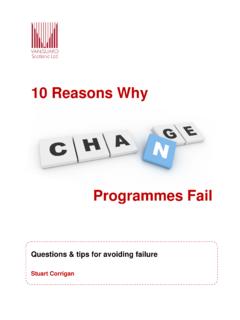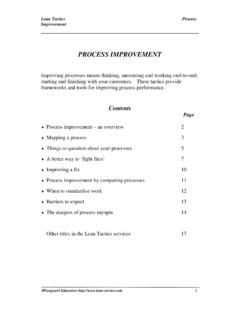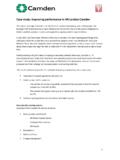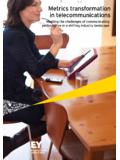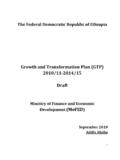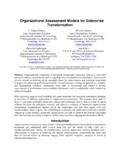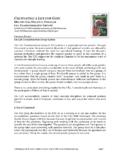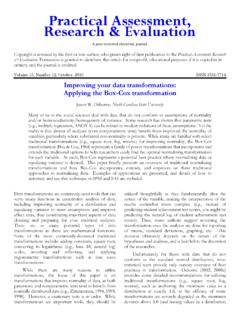Transcription of THE TRANSFORMATION OF O2 A VANGUARD …
1 THE TRANSFORMATION OF O2 A VANGUARD CASE STUDY The TRANSFORMATION of O2 a VANGUARD Case study 1 Introduction In December 2012 Julie Collins, Head of GoodLife1 for O2 decided that the traditional model both she and her peers were using to run the Telecomm giant s contact centres were no longer providing incremental improvement. As Julie reports, I knew from listening to customer demand that the issues were coming from other parts of the business but I didn t have a method or approach to influence change in other parts of the business. This is a common problem for call centre managers, mainly because they all run their operations in the same way. Typically management have four main points of focus: 1. PCA percentage of calls answered, or the reverse equation, percentage of calls abandoned.
2 2. TCHT Total call handling time, typically made up of talk time and after call work. 3. CSI Customer service index scores. 4. People management. These measures and foci are ubiquitous in the industry and are used to control all facets of the business. For example if operating costs start to increase then the manager simply adjusts the TCHT downwards. The assumption being that if more calls can be handled in less time then there will be an opportunity to reduce headcount and hence reduce costs. If PCA starts to suffer, again the answer is to adjust the TCHT. More calls handled in less time means more And if there is a problem with the CSI scores managers will typically ask the adviser to be extra nice or give them a script like after this call you ll get a text about the service you received today, I trust you were happy with our service and you ll take that into account when you get the text.
3 In some cases managers even coach a focus on topical conversations, for example linked to where the customer lives, in order to build rapport and improve CSI scores. The problem with these methods is the unintended consequences of their execution. TCHT is an arbitrary number which is simply the output from dividing the number of expected calls by the number of available hours. This provides the manager with the time that must be hit if the centre is to handle all calls. Typically this number is dished out as a target and advisers managed against the number. Those failing to hit their TCHT get reprimanded. CSI can be, and is, manipulated by what advisers promise to customers and often it ends in a complaint. As Julie said I was fed up with the industry standard operating model, I knew it didn t work and simply caused problems for us in different parts of the business.
4 I d been round this circle numerous times, I wanted to do something differently. I also knew that measuring total call handling time was driving the wrong behaviours but simply removing TCHT as a measure also made no difference. 1 Goodlife is the name for customer service in O2. The role of this area is to handle calls from customers once they have arranged a new contract. 2 When PCA is low some managers will ask operators pick up the phone take a number and promise the customer a call back a later date. The TRANSFORMATION of O2 a VANGUARD Case study 2 Understanding the Problem Julie decided that the starting place was to do Check . Check is a term invented by John Seddon, head of consulting firm VANGUARD .
5 VANGUARD s Systems Thinking model allows managers to study the contact centre from the perspective of the customer and understand the negative consequences associated with targets, incentives and badly designed processes and policies. Julie disclosed that, looking at my business from a different perspective was both an enlightening and painful experience. It made me see that some of the assumptions we use to run contact centres are completely flawed . The high level output of Check provided data in a number of areas: 1. The number of calls handled in one stop from the customer s perspective. 2. The number of calls passed on to other areas. 3. The number of calls passed back to the customer with no resolution. 4. The number of calls where a commitment was made to further action, called Set Up For Resolution.
6 5. The volume of calls deemed Value demand ; a call related to the organisation s purpose and typically a revenue generating call. 6. The volume of Failure demand calls; calls caused by a failure of the organisation to do the right thing for the customer. The results weren t pretty but are also not uncommon in the industry. And as we did more digging we found more problems, especially in the SUFR category. Many of the customers in this category assumed that their query had been closed when it hadn t. Typically an adviser would fill in a form to have a request fulfilled for a customer but as there were frequently long delays in resolution, the customer would repeatedly call back to chase progress (failure demand calls). To understand this further Julie and her team started to study individual customer journeys.
7 More harsh reality ensued. 75% of all calls into Goodlife were failure demand calls. Only 33% of the calls were sorted there and then . 17% of calls were passed on to another department. 4% were passed back to the customer without resolution. 46% were set up for resolution (known as SUFR). The TRANSFORMATION of O2 a VANGUARD Case study 3 Dorothy, a 67 year old, had the kind of experience not uncommon in the telecoms industry. She called O2 looking for an easy to use mobile. She was given a Samsung Galaxy not an easy to use mobile. Within two weeks she was back wanting to switch her phone. And was given another easy to use phone [sic] an Apple iPhone 4. This was a classic SUFR transaction. The adviser had to complete a form to have the old phone cancelled.
8 The form went to India to be processed due to lower transaction costs, but the agent in India cancelled the wrong phone. This resulted in Dorothy getting a cancellation notice and numerous bills for the cancellation of the Apple iPhone. More visits to the O2 retail store and more phone calls to O2 ensued. In the end Dorothy made or received: 5 store visits 3 contacts from the store 7 incoming calls from Dorothy 4 calls back to Dorothy 3 webchats .. before the problem was resolved. This highlights a major problem with the call centre industry. Each of those transactions was within standard the adviser complied with the time allocated to handle the call and was polite and friendly. But no one had an end to end view of the customer experience, so the real cost of the transaction was never calculated.
9 Additionally each of those calls, visits and webchats were failure demand but as call centre managers do not tend to differentiate between value and failure demand, no attempt is made to get underneath the reason for the call and ascertain whether it s a predictable problem and should be turned off. The data led us to our first question what to change? What to Change Studying the system revealed that what should be changed is contrary to what would normally be tackled in the industry. Julie comments, we d normally take action on the advisers and ask them to be more active, try to re engineer processes or cross skill our resource pool, but we d never before decided to tackle the sacred cows measures and targets, functional design, authority levels, IT access and but now we had the evidence everything was up for grabs.
10 The first problem was the functional design of the business. Because advisers had been placed into skill groupings and were being measured against call handling time we were making it easy for them not to want to take the call, citing this call is not for me . And management behaviour reinforced the view that calls should be passed on so that the agent could hit their TCHT. The second issue was the targets. Because TCHT assumed an average call time some advisers would come in higher than average (this is the nature of having an average number). The problem was not however an agent issue, it was based on the type of calls they got that day. For example failure demand calls take longer to handle than value demand calls. The TRANSFORMATION of O2 a VANGUARD Case study 4 Next were incentives.
